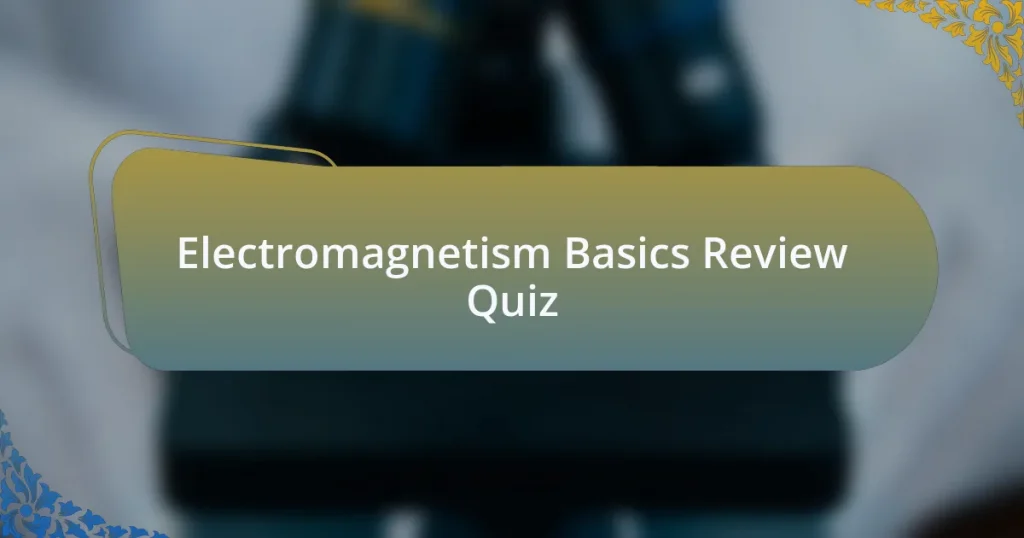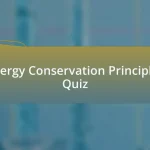Start of Electromagnetism Basics Review Quiz
1. What is an electromagnetic field?
- A phenomenon that occurs exclusively in the presence of nuclear forces.
- An energy source that powers electrical devices without change.
- A static force that only applies to moving objects in a vacuum.
- A physical aura generated by charged particles and particles possessing a magnetic moment.
2. What generates an electric field?
- A neutral particle in motion.
- An electrically activated particle.
- A static magnetic field.
- A permanently charged particle.
3. What is Gauss’s Law?
- The principle that electric charges generate an electric field, and the total electric flux through a closed surface is proportional to the charge enclosed by that surface.
- The theorem that states electric potential is constant around closed loops in a circuit.
- The idea that gravitational fields are created by massive bodies in space.
- The law stating that magnetic fields are generated by electric currents passing through conductors.
4. What is Faraday’s Law of Induction?
- The principle that electric charges generate a magnetic field.
- The principle that a constant magnetic field produces no effect.
- The principle that a varying magnetic field produces an electric field.
- The principle that electric fields cannot produce magnetic fields.
5. What is Ampère’s Law?
- The principle that an electric charge in motion generates a magnetic field.
- The principle that magnetic fields are created by electric potential difference.
- The principle that electric fields produce gravitational fields.
- The principle that static charges emit electromagnetic radiation.
6. What is the Ampère-Maxwell Law?
- A theorem that indicates electric fields transition into gravitational fields in certain conditions.
- A law stating that electric fields are produced solely by stationary charges.
- The combined principle of Ampère’s Law and Faraday’s Law of Induction, showing how electric and magnetic fields are produced and changed by each other.
- A principle that describes how magnetic fields can exist without electric fields.
7. What is electromagnetism?
- The interaction between electrically active particles and the electromagnetic field, including all physical processes related to electric fields and magnetism.
- The study of motion in space and time without considering forces or interactions.
- A description of how gravitational forces act between two masses.
- The investigation of thermal energy transfer through conduction and convection.
8. What are the main differences between an electric field and a magnetic field?
- Electric fields and magnetic fields are always the same in their behavior and effects.
- Electric fields are found only in superconductors, while magnetic fields exist everywhere.
- Electric fields are used for shielding, whereas magnetic fields are solely for power transmission.
- Electric fields are generated by stationary charges, while magnetic fields arise from moving charges.
9. What is a north pole?
- The center of a magnet where forces cancel out.
- A location where electric fields are strongest.
- A point on a magnet from which the magnetic field lines emerge.
- A point where light waves are concentrated.
10. What is a south pole?
- A point on a magnet to which the magnetic field lines converge.
- A geographical region at the bottom of Earth.
- A type of electrical charge in elementary particles.
- The location of a planet`s south pole.
11. What are the main examples of electromagnetic radiation?
- Mechanical waves, static fields, gravitational waves.
- Sound waves, thermal waves, pressure waves.
- Electric currents, chemical reactions, nuclear reactions.
- Light, radio waves, X-rays, gamma rays, and microwaves.
12. What is an electromagnet?
- A tool that measures electric current in a circuit.
- A type of transformer that converts magnetic energy into electrical energy.
- A permanent magnet that produces a constant magnetic field without any power source.
- A device that generates a magnetic field when electric current flows through a coil of wire wrapped around a magnetic core.
13. How do electromagnets work?
- By using a single wire to directly create a magnetic field without any coils.
- By generating electric charges that produce a stable magnetic field independently.
- By creating a magnetic field perpendicular to the direction of current flow through the coil of wire.
- By relying solely on permanent magnets to create magnetism without current.
14. What are the applications of electromagnets?
- They are used to store energy in batteries and capacitors.
- They are used in electric motors, lifting heavy objects, medical imaging, and trains.
- They are used to measure the speed of light in vacuums.
- They are used for quantum computing and data storage.
15. What is Gauss’s Law for magnetism?
- The idea that magnetic monopoles exist and can be isolated.
- The assertion that the total magnetic flux through a closed surface is proportional to the electric charge inside.
- The concept that there are no magnetically charged particles, meaning many theoretically probable genres of magnetic fields do not exist.
- The principle stating that electric fields and magnetic fields are independent of each other.
16. What is the right-hand rule?
- A guideline for predicting the motion of falling objects.
- A technique for measuring electric resistance in circuits.
- A rule used to determine the direction of the magnetic field generated by a current-carrying wire.
- A method for calculating gravitational force between two masses.
17. What happens when a wire loop is displaced towards or away from a magnet?
- A current is generated in the wire loop.
- The wire loop melts.
- The wire loop turns into an insulator.
- The wire loop becomes magnetized.
18. What is the B-H curve?
- A chart used to measure the resistance of materials in magnetic fields.
- A normal magnetization curve showing the relationship between magnetic field strength and magnetic flux density.
- A graph showing the correlation between voltage and electric current.
- A diagram illustrating the various types of electric charges.
19. What is the knee in the B-H curve?
- The point where increases in the field strength no longer have much effect on the magnetic flux density.
- The area where magnetism is first generated in materials.
- The point at which magnetic fields become constant and unchanging.
- The section where magnetic saturation begins to occur in the material.
20. What is Faraday’s Law of Induction used for?
- To determine the mass of an electron.
- To measure gravitational forces between two objects.
- To explain how a varying magnetic field produces an electric field.
- To calculate the speed of light in a vacuum.
21. What is Ampère’s Law used for?
- It is used to explain how magnetic fields repel each other.
- It is used to analyze the color spectrum of light.
- It is used to explain how an electric charge in motion generates a magnetic field.
- It is used to describe how light travels through a vacuum.
22. What is the Ampère-Maxwell Law used for?
- It is used to combine Ampère’s Law and Faraday’s Law of Induction, showing how electric and magnetic fields are produced and changed by each other.
- It is used to explain the behavior of light in different materials.
- It is used to calculate the speed of sound in different mediums.
- It is used to determine the force between two charged particles.
23. What are the main mathematical representations of magnetic fields?
- Coulomb`s Law defines the force between electric charges.
- Maxwell’s equations show how magnetic and electric fields are produced and changed by each other.
- Newton`s Laws describe motion and forces affecting physical objects.
- The Schrödinger equation is used for quantum mechanics and wave functions.
24. What is the Special Theory of Relativity related to?
- It pertains solely to thermodynamics and energy transfer.
- The theoretical consequences of electromagnetism led to the construction of the Special Theory of Relativity.
- It deals exclusively with gravitational forces and celestial mechanics.
- It primarily focuses on quantum mechanics and particle interactions.
25. What happens when electric current flows through a coil of wire wrapped around a magnetic core?
- A magnetic field is generated perpendicular to the direction of current flow.
- The coil becomes a permanent magnet with no current required.
- The coil produces electric energy without a magnetic field.
- The wire heats up but does not create a magnetic field.
26. How can you build an electromagnet at home?
- Connect two metal rods with glue and place them in a microwave.
- Wrap insulated copper wire tightly around an iron nail or bolt, connect it to a power source, and observe the magnetic field.
- Use a rubber band to connect wires to aluminum foil and place it near a battery.
- Mix copper powder with water and pour it over a magnet.
27. What are iron filings used for in an electromagnet experiment?
- To visually demonstrate the magnetic field by aligning along the magnetic field lines.
- To create a permanent magnet for experiments.
- To increase the voltage of the power source used.
- To absorb excess electric current in the circuit.
28. What is the purpose of alligator clips in an electromagnet experiment?
- To create resistance in the experiment.
- To measure the voltage across the coils.
- To connect the wire to the power source.
- To generate heat in the circuit.
29. What is the purpose of a power source in an electromagnet experiment?
- To measure electric current flow.
- To reduce resistance in the circuit.
- To create a permanent magnet.
- To energize the electromagnet and generate a magnetic field.
30. What is the difference between a permanent magnet and an electromagnet?
- A permanent magnet retains its magnetic field without an external power source, while an electromagnet requires an external power source to generate its magnetic field.
- A permanent magnet generates electricity, while an electromagnet does not.
- A permanent magnet can be turned on and off, while an electromagnet cannot.
- A permanent magnet is made only of iron, while an electromagnet can be made of any metal.
Congratulations on Completing the Quiz!
Well done on finishing the quiz on Electromagnetism Basics! This topic is foundational in physics, and your participation shows your dedication to mastering these concepts. Throughout the quiz, you may have reinforced your understanding of key principles such as electric fields, magnetic fields, and their interactions. These are essential building blocks for more advanced topics in physics.
The insights gained from this quiz can help you in various applications, from understanding how everyday electrical devices work to exploring more complex phenomena like electromagnetic waves. Each question provided a chance to test your knowledge and identify areas for further study. You’ve actively engaged in your learning journey, which is a significant step towards achieving your academic goals.
If you’re eager to expand your understanding even further, we invite you to check out the next section on this page. It offers comprehensive information on Electromagnetism Basics, including detailed explanations, examples, and practice problems. Deepening your knowledge in this area will greatly enhance your skills in physics test preparation. Happy learning!
Electromagnetism Basics Review
Introduction to Electromagnetism
Electromagnetism is a fundamental branch of physics that studies the interaction between electric charges and magnetic fields. It encompasses both electric forces and magnetic forces, which are unified by the concept of the electromagnetic field. This field describes how charged particles interact and influence one another, leading to phenomena such as electricity and magnetism. Understanding the basics is essential for grasping more complex concepts in physics, especially in areas relating to circuitry and wave propagation.
Key Concepts of Electric Fields
An electric field is a region around a charged particle where a force would be exerted on other charges. The strength and direction of this field can be represented visually by electric field lines. The formula for the electric field (E) created by a point charge (Q) is defined as E = k * |Q| / r², where k is Coulomb’s constant and r is the distance from the charge. This relationship highlights how electric fields diminish with increasing distance from the charge, a critical point in electricity-related physics problems.
Magnetic Fields and Their Properties
A magnetic field represents the influence of magnetic forces generated by moving electric charges. The magnetic field (B) can be visualized using magnetic field lines, which show the direction and strength of the field. The field varies according to the current flowing through a conductor, described by Ampère’s law, which states that the magnetic field in space around an electric current is proportional to the current. Understanding these properties is vital for tackling topics like electromagnetic induction and electromagnets.
Electromagnetic Induction Principles
Electromagnetic induction occurs when a changing magnetic field creates an electric current in a conductor. Faraday’s law of induction quantifies this relationship, stating that the induced electromotive force (EMF) is proportional to the rate of change of the magnetic flux. This principle is foundational in the operation of electric generators and transformers. Mastering these concepts is essential for solving problems related to circuits and energy transfer in physics exams.
Applications of Electromagnetism in Technology
Electromagnetism plays a crucial role in modern technology, impacting devices such as motors, generators, and communication systems. These applications rely on the principles of electric and magnetic fields for efficient operation. For instance, electric motors convert electric energy into mechanical energy through electromagnetism, allowing for motion in various machines. Examining these applications aids in comprehending real-world phenomena and their underlying physics principles, which is important for test preparation.
What is Electromagnetism?
Electromagnetism is a fundamental branch of physics that studies the relationship between electric charges and magnetic fields. It combines both electric phenomena, such as static electricity and electric currents, with magnetic effects, such as magnetism produced by moving charges. Electromagnetism is governed by Maxwell’s equations, which describe how electric and magnetic fields interact. This theory is essential in explaining how various technologies, such as motors and generators, operate, highlighting its relevance in everyday applications.
How does Electromagnetism work?
Electromagnetism works by describing how electric charges create electric fields and how these fields, in turn, affect other charges. When a charge moves, it generates a magnetic field around itself. This interaction allows electric currents to produce magnetism, and vice versa. The behavior of these fields and their interactions are quantified by mathematical laws, including Coulomb’s law for electric forces and the Biot-Savart law for magnetic fields. This understanding is critical for various devices, from electric circuits to wireless communication technologies.
Where is Electromagnetism applied?
Electromagnetism has widespread applications in numerous fields including electronics, telecommunications, medical imaging, and power generation. For instance, it is the principle behind electrical circuits, which are fundamental in all electronic devices. Additionally, electromagnetism is utilized in technologies like MRI machines, which use strong magnetic fields to visualize internal body structures. Furthermore, it plays a vital role in the generation and distribution of electrical power through transformers and power lines.
When was Electromagnetism discovered?
Electromagnetism was formally established in the 19th century, particularly with the work of scientists like James Clerk Maxwell, who published his famous set of equations in 1865. Prior to Maxwell, experiments by Hans Christian Ørsted in 1820 demonstrated a connection between electricity and magnetism, laying the groundwork for the theory. The comprehensive unification of electric and magnetic phenomena as electromagnetism occurred as a result of these cumulative discoveries, leading to significant technological advancements.
Who discovered the principles of Electromagnetism?
The principles of electromagnetism were developed through the contributions of several key scientists. Hans Christian Ørsted is credited with the initial discovery of the relationship between electricity and magnetism in 1820. André-Marie Ampère followed with formulas quantifying this relationship. Later, James Clerk Maxwell unified these concepts in his equations, forming the foundation of modern electromagnetic theory. These contributions collectively shaped our understanding of electromagnetic phenomena and their applications.















